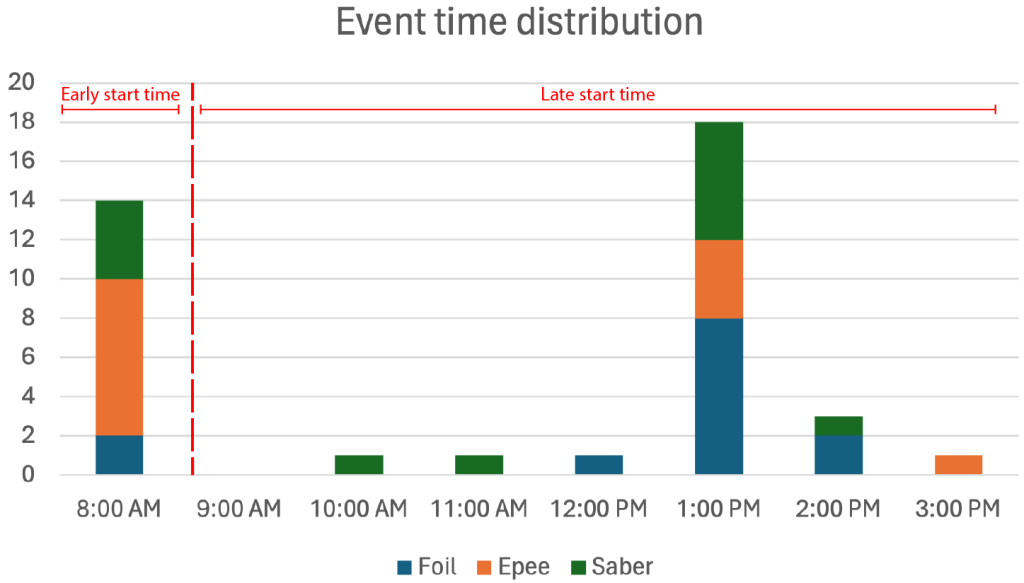Many parents, fencers, and coaches have expressed frustration on social media that East Coast North American Cups (NACs) are problematic for West Coast fencers. Morning events on the East Coast translate to 5:00 AM on West Coast time, and fencers often have to wake up 1-2 hours earlier than their event start time to eat breakfast and warm up. One would expect an early start time to have a negative effect on performance. Try performing at your best at 5:00 AM when you’re exceptionally groggy!

I wanted to determine if early East Coast start times have a causal effect on the performance of West Coast fencers, specifically whether these early start times lead to poorer results for West Coast fencers at events. Sneak peek into the conclusion: they probably don’t!
Why are natural experiments important?
Measuring a causal effect is very challenging. It is so complex that Nobel Prizes have been awarded to those who have developed new methods for measuring it. Let’s say we are analyzing the impact of a new drug on people. Determining causation is difficult because we cannot measure the counterfactual – the outcome if the individual had not received the treatment. Additionally, we cannot simply compare the average outcomes of treated versus untreated individuals because treated individuals may differ in characteristics from untreated ones, leading to confounding factors.
In the context of fencing, we want to compare the performance of West Coast and East Coast fencers when an East Coast NAC (North American Cup) starts early in the morning. The treatment is the early East Coast start time. However, a direct comparison between East Coast NACs and all other NACs isn’t straightforward because the individuals willing to endure the long flight and miss school for an East Coast NAC are likely to be highly committed and perhaps more skilled fencers. This creates a confounding variable, as the West Coast fencers who participate (“treated”) are typically more skilled at fencing.
This is why randomized control trials (RCTs) are often considered the “gold standard” for determining causality; individuals are randomly assigned to treatment or control groups, making it unlikely that the groups will have substantial differences. Therefore, we can directly compare the treated and untreated groups to determine the causal effect of the treatment.
In observational data, which is what we have access to, our best chance to uncover causal evidence is through a natural experiment—where we can reasonably assume that the treated group resembles the untreated group.
Fencing’s natural experiment
It seems reasonable to assume that the start time of an event is quasi-random and uncorrelated with skill. Although male events are generally in the morning (only one Junior Men’s Foil event in my sample was in the afternoon), we can focus solely on female events to guarantee a balanced distribution of morning and afternoon events. We specifically restrict our sample to female Junior events, which have a similar number of morning and afternoon start times, making it plausible that the event time is random. Additionally, the Junior category happens to have the largest sample sizesample size the number of individual observations or data points collected from a population for use in statistical analysis or experimentation of East Coast events. We also look at pool bouts rather than DE bouts since there are a larger sample of pool bouts and fencers may have already “woken up” and feel alert by the time they get to the DE round.
Since event times are typically announced only about a month in advance, fencers are unlikely to withdraw after seeing the event time. Therefore, the inherent characteristics of East Coast events with 8:00 AM start times are unlikely to substantially differ in terms of fencer skill compared to 1:00 PM events, which allow fencers from both coasts to wake up at more reasonable times. We also assume that USA Fencing does not disproportionately assign events with stronger West Coast fencers to either the morning or the afternoon.
East Coast fencers and West Coast fencers adhere to the natural definition of East and West Coast. East Coast fencers are those who reside in a division on Eastern Time (ET), and West Coast fencers are those who reside in a division on Pacific Time (PT). Similarly, an “East Coast event” is an event in a city that follows ET. We only analyze bouts from East Coast events that have exactly one West Coast and one East Coast fencer since our goal is to measure how West Coast fencers do against East Coast fencers at an early event versus a late event.

An event has an “early start time” if it starts between 8 and 9 AM, and is otherwise not considered an early start time. There were few events that started between 9 AM and 12 PM, so most “late start time” events are in the afternoon. Excluding late morning event times did not change the results.

We also control for the number of fencers in the event in case there is confounding where larger events are more likely to be put in the morning and also have more weak/strong fencers from either coast. Our results are not sensitive to the inclusion of this control. Since there may be correlation between the performance of West Coast fencers versus East Coast fencers at a specific event and all fencers at an event are impacted (“treated”) by the early start time, we cluster bouts from the same event in the regression analysis, following the advice of Abadie et al. (2021). Clustering only affects the standard errors, and it won’t change our estimate for the effect of early start times. In the end, our regression formulas is
(West Coast fencer score – East Coast fencer score) = α·(number of fencers in event) + β·(early start time)
Where our variable of interest is β, the effect of the early start time.
Results and Conclusion
In all three weapons, there was no evidence that early start times led to worse performance for female West Coast fencers in the Junior category. The estimated effects of early start times are negligible (less than 0.06 points in either direction). Moreover, the p-values, all exceeding 0.05, indicate that the observed effects could likely be attributed to random chance.
| Weapon | Effect of 8:00 AM event on West Coast fencer’s score | 95% confidence intervalconfidence interval a range of values calculated from sample data that is likely to contain the true population parameter, providing a measure of the uncertainty or precision of an estimate | p-value | n |
|---|---|---|---|---|
| Foil | -0.0074 points | (-0.463, 0.448) | 0.975 | 1590 |
| Epee | -0.0572 points | (-0.332 0.218) | 0.684 | 1325 |
| Saber | 0.0082 points | (-0.779 0.795) | 0.984 | 1602 |
While my analysis focuses solely on female events due to their variation in start times, I believe these results could extend to male fencers as well. It seems unlikely that early start times would have a significant effect on male fencers while not affecting female fencers.
As a West Coast fencer, although I agree that it is annoying to travel 5+ hours to the East Coast to fence, it is reassuring that it (probably) won’t affect my performance. In spite of this, I still argue that there should be more West Coast NACs. East Coast NACs are still more expensive and inconvenient for West Coast fencers, and exacerbate socioeconomic inequality in this already extremely costly sport. Let’s hope for some more West Coast NACs in the 2025-2026 season!
References
Abadie, A., Athey, S., Imbens, G. W., & Wooldridge, J. M. (2023). When should you adjust standard errors for clustering?. The Quarterly Journal of Economics, 138(1), 1-35.
